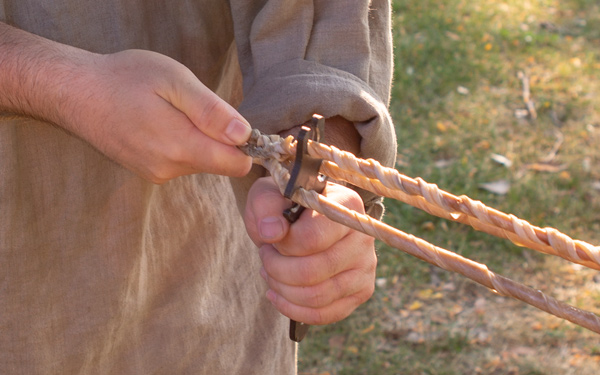At Provision Camp, the expedition readies the hunt and makes new elk hide rope. Pryor’s detachment explores the Quicksand River—the present Sandy in Oregon. Visiting Indians of various Nations warn there is no food upriver, and that the salmon will not come for another month. Lewis buys a Chinookan canoe for 6 fathoms of wampum beads.
Quicksand (Sandy) River
© 26 March 2012 by Kristopher K. Townsend. Permission to use granted under the Creative Commons Attribution-Share Alike 4.0 International license.
The ‘Quicksand’ River
This morning early we dispatched Sergt. Pryar [Pryor] with two men in a small canoe up quicksand [Sandy] river with orders to proceed as far as he could and return this evening.
—Meriwether LewisI went up Quick Sand River about 4 Miles. [The river] is 350 Yards wide & only 50 Yards of Water the remainder being entirely a Quick Sand.
—Joseph Whitehouse
Making Elk-Skin Rope
Elk hide and rope-making tools provided by John W. Fisher. Photo © 2014 by Kristopher K. Townsend. Permission to use granted under the Creative Commons Attribution-Share Alike 4.0 International license.
Making Elk-skin Rope
employed those about camp in making a rope of Elkskin.
—Meriwether Lewis
Grim Prospects
We were visited by several canoes of natives in the course of the day; most of whom were decending the river with their women and children. they informed us that they resided at the great rapids and that their relations at that place were much streightened at that place for the want of food . . . . they informed us that the nations above them were in the same situation & that they did not expect the Salmon to arrive untill the full of the next moon . . . .
—Meriwether Lewis
The Middle Columbia
Edward S. Curtis (1868–1952)
Photo © 2001 Northwestern University Library, Edward S. Curtis’s ‘The North American Indian’: the Photographic Images.
A Need to Leave
it was at once deemed inexpedient to wait the arrival of the salmon as that would detain us so large a portion of the season that it is probable we should not reach the United States before the ice would close the Missouri; or at all events would hazard our horses which we lelft in charge of the Chopunnish . . . . we are therefore determined to loose as little time as possible in geting to the Chopunnish Village.
—Meriwether Lewis
Deal, No Deal
I purchased a canoe from an Indian today for which I gave him six fathoms of wampum beads; he seemed satisfyed with his bargain and departed in another canoe but shortly after returned and canceled the bargain; took his canoe and returned the beads.
—Meriwether Lewis
Celestial Observations
Observed Meridian Altitude of Sun . . . . it was so cloudy at the time of this observation that cannot vouch for any great accuracy.—
—Meriwether Lewis
Slender toothwort
Cardamine nuttallii
Photo © 2012 Walter Siegmund. Permission to use granted under the Creative Commons Attribution-ShareAlike 3.0 Unported license.
Slender Toothwort Specimen
Aprl. 1st 1806.
Columbia near Quicksand R.
—Meriwether Lewis[1]Cardamine nuttallii. Moulton, ed. Herbarium, specimen 35.
Weather Diary
State of weather at rise
Wind at rise
State of the weather at 4 P.M. Wind at 4 P.M. River cloudy after fair S E cloudy after fair S E raised 1 in. at 6 P. M. last evening it became cloudy. Cottonwood in blume. From the best opinion I could form of the State of the Columbia on the 1st of April it was about 9 feet higher than when we decended it in the begining of November last. the rising and falling of the river as set down in the diary is that only which took place from sunseting to sunrise or thereabouts it being the time that we usually remain at our encampments.—
—Meriwether Lewis[2]To assist the reader of this web page, the date column is not presented, the “State of the Columbia River” columns have been merged, and some abbreviations have been spelled out.
Experience the Lewis and Clark Trail
The Lewis and Clark Trail Experience—our sister site at lewisandclark.travel—connects the world to people and places on the Lewis and Clark Trail.
Plan a trip related to April 1, 1806:

Sandy River Delta is a High Potential Historic Site along the Lewis and Clark National Historic Trail managed by the U.S. National Park Service. The 1400-acre Sandy River Delta park, managed by the U.S. Forest Service, has an extensive trail system.






